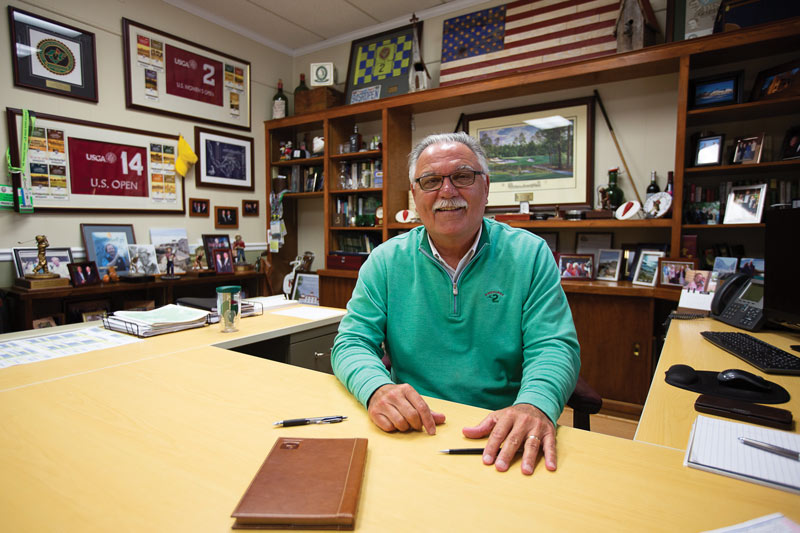
Bob Farren, CGCS, has been integral to many milestones at Pinehurst Resort, among them hosting back-to-back U.S. Opens — first the men, then the women — in 2014, the first time two majors were ever played at the same site in consecutive weeks. Now, another first: GCSAA recently announced Farren is the winner of the association’s inaugural Col. John Morley Award. Photo by Tim Sayer/Pinehurst Resort
It would be easy to dismiss the name of a short stretch of road smack-dab in the middle of tiny Tornado, W.Va., as mere coincidence.
There’s really no good reason for this particular stretch of pavement, running roughly 900 feet, to bear the name Pinehurst Drive, though once you learn the history of the area, it’s hard not to hear the sound of cosmic tumblers clicking into place or envision the universe thumbing its nose at the concept of “coincidence.”
See, where Pinehurst Drive is now — the one in Tornado (population: 1,187), roughly a five-hour drive from the illustrious golf complex of the same name — is roughly halfway between Andrews Heights Elementary School, where Marilyn Farren taught, and Big Bend Golf Course, where Bob Farren Sr. worked as superintendent. And it’s roughly where Bob Farren Jr., CGCS, spent his formative years, though that part of town had more farmland than pavement at the time.
The origin story of the younger Farren, as he has often told it, has him perpetually riding his bike one way, to the school, or the other, to the golf course. So should it come as any surprise that the man synonymous with Pinehurst would find that name popping up everywhere he goes or has been?
After all, this is a man who, when he was younger, not only knew what he wanted to be but where he wanted to do it, when he’d had plenty of insight into the former but absolutely none into the latter.
“Really and truly, believe it or not, when I was in college, people would ask, ‘What do you want to do when you get out of school?’” recalls Farren, now Pinehurst’s director of golf course and ground management, a 41-year GCSAA member, and the winner of the 2022 Col. John Morley Award, the highest award the association gives to superintendent members. “I would always say I wanted to be a golf course superintendent. Not only would I say that, I would finish that, literally, with, ‘... and live in North Carolina.’ The irony is, I’d never even been to North Carolina. I just had that feeling.”
Pinehurst proclaims itself the Cradle of American Golf, so what does that make Farren, as its preeminent caretaker?
“I can think of no one since the Maples family, who were superintendents there in the early years, but beyond that, I can think of no one more influential in the success and evolution of Pinehurst than Bob Farren,” says Bill Coore, half of the famed Coore & Crenshaw firm that, audaciously, retooled Pinehurst’s flagship No. 2 course back in 2010 and 2011. “Certainly not from an agronomy and on-the-ground standpoint.”
And despite all that, Farren somehow remains grounded.
“He truly is a pleasure to be around,” Coore says of Farren, to whom some in the industry refer as “the most interesting man in turf,” given his more-than-passing resemblance to the most interesting man in the world in those old beer commercials. “You could imagine someone with his experience and his knowledge at a place like Pinehurst being a bit ... inflated ... in terms of their impression of themselves. They might think they’re something pretty darn special. Bob doesn’t. You just get the feeling he’s as happy to be associated with Pinehurst today as when he first started there. He’s just a delightful guy. He’s not in any way infatuated with himself or his reputation. He’s just a guy who goes out and goes to work every day.”
Like father, like son
That Farren takes the lunch-pail approach to work is a testament to his father, the late Bob Farren Sr. The first in the family to try to make a living in golf — his dad was in logging — Bob Sr. was involved in the construction and then maintenance of Big Bend Golf Course in Tornado before, much later, moving on to Hurricane, W.Va.
Before those malevolent meteorological tides turned, Bob Sr. staffed his Big Bend crew mostly with his eager young son — to whom the elder Farren fondly referred as “Punk” — and Punk’s friends from school.
“I really never had any desire to do anything but this,” Farren says. “I don’t know why — probably because I spent so much time at the golf course with my father and his friends. They were like uncles to me, so it was like one big family. I just grew up going there since I was 8, 9, 10 years old. In my high school years, I worked on the golf course, then we’d play on the golf course. It was just a big fraternity of people.”
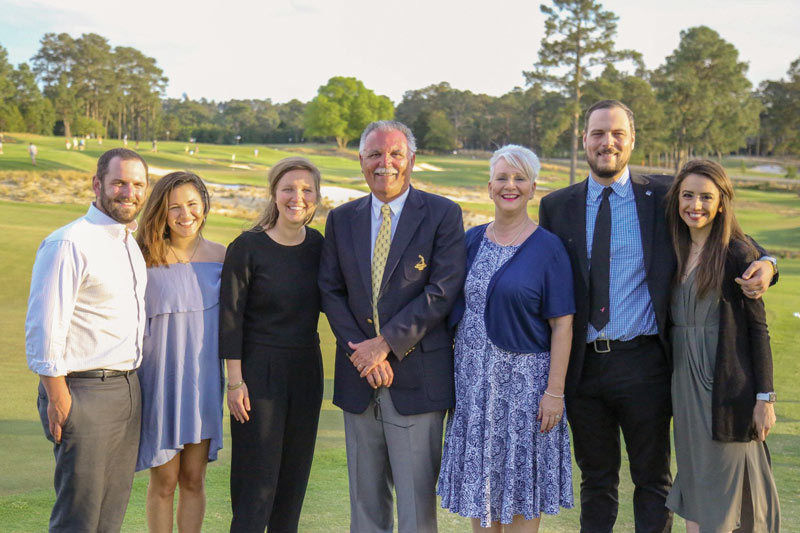
Farren (center) with friends and family (from left): Christian Johnstone, Emily Johnstone, daughter Kristin Farren, wife Kathy Farren, son Casey Farren, and daughter-in-law Megan Farren. Photo courtesy of Pinehurst Resort
Though he planned to follow his father’s footsteps into golf course superintendency, Farren didn’t study turf in college. The nearest turf school was Virginia Tech, but Blacksburg, Va., was far enough away that it would prevent Farren from continuing to work on the golf course when he wasn’t studying. Huntington, W.Va., was considerably closer, so Farren studied recreation and tourism at Marshall University instead and worked on the golf course as his studies allowed.
“Marshall has a great program in what is now under the general umbrella of hospitality, and I knew that would be applicable to the golf course business,” Farren says. “And I’d glean anything from the agronomic side that I could. Virginia Tech has a great agronomy program, and my dad would go to their field days every fall, so I went when I was old enough.
“That was my plan, to be on the golf course while I was working on my degree learning the hospitality aspect. I don’t know if it was poor planning or just a great deal of confidence, but I didn’t have any other plan. That was it.”
The year before he graduated from Marshall, in 1978, Farren had his first introduction to Pinehurst. Sort of.
A green committee chairman friend of his father’s encouraged the younger Farren to attend the International Turfgrass Conference and Show in San Antonio, hoping to inspire the lad. Bob Jr. sat in on a presentation from Bob DePencier, Pinehurst Country Club’s manager of golf at the time.
“I was really intrigued and motivated by that,” Farren says. “From that point on, even though I didn’t say it, I was interested in coming to Pinehurst.”
Called to Carolina
The move to Pinehurst didn’t take long.
Upon graduation, Farren went to work as supervisor of golf courses and grounds for Kanawha County (W.Va.) Parks, which at the time featured three golf courses — a nine-holer, a par-3 and an 18-holer — and various other athletic fields. During Farren’s three-year tenure, the county acquired Big Bend, the course his father had helped build and maintain.
In 1982, Pinehurst came calling, impressed in part by Farren’s multicourse experience. That year, Farren became assistant superintendent on Pinehurst’s No. 1 and No. 4 courses. He was promoted to superintendent of No. 4 for 1983-84.

The Cradle at Pinehurst Resort. Designed by Gil Hanse, the nine-hole short course measures 789 yards and features holes ranging from 56 to 127 yards. Photo courtesy of Pinehurst Resort
The rest was not history, however. Though it’s often said that Farren has been at Pinehurst since 1982, that’s not quite right. For a nine-month span in 1984 and ’85, he left his dream destination for Berry Hills Country Club in Charleston, W.Va.
Somehow, even leaving Pinehurst led him back there.
See, when Farren started at Pinehurst, the complex was in a bad way. The company that owned it had been keen to focus on real estate, and the recession of the early 1980s had left the facility gutted. Banks took possession of Pinehurst’s properties hoping for a buyer, and one, ClubCorp, finally came along in 1984.
“It was known that they were going to buy it, and the rumors were that they were going to come in and clean house, fire everybody,” Farren says. “I felt it was fate when another club in West Virginia reached out to dad and to me to see if I was interested in coming up there. I thought, ‘Maybe I should do this.’ I was engaged at the time to a young lady I met here. She was in favor. She grew up there, and it was an adventure. I never really had my heart in leaving, but she encouraged me to do it. Not long after I accepted the position, Brad Kocher was announced to become the director of operations here. I met with him and told him I planned on leaving. He offered me an opportunity to stay, but I felt committed to go to Berry Hills, partially because dad was still in the community. I didn’t want to take the job and walk out on them. It would reflect poorly on him.”
After nine months at Berry Hills, Farren’s phone rang. It was Kocher, asking Farren to come home.
“He asked if I would be interested in coming back as superintendent of No. 2, which was the granddaddy,” Farren recalls. “I don’t know if it all would have transpired like that if I had stayed there, on No. 4. It worked out really well.”
It has been a steady climb for Farren ever since: superintendent on No. 2 and No. 6 in 1985; assistant director of golf course and ground management from 1986-2001; and director of golf course and ground management since 2001.
And they weren’t exactly uneventful years. They never are at Pinehurst.
When Farren first joined the Pinehurst family, the complex was six courses. Farren was around for the construction (1986) and renovation (2002) of No. 7; the build of No. 8 (1996); the acquisition of No. 9 in 2014; plus the construction of the resort’s newest and shortest course, the par-3, nine-hole Cradle, and the Thistle Dhu putting course.
And Farren played a key role in the controversial-at-the-time renovation of the signature No. 2, which has been the site of more golf championships than any other course in the U.S., having hosted the U.S. Open, PGA Championship, Ryder Cup, PGA Tour Championship and many others.
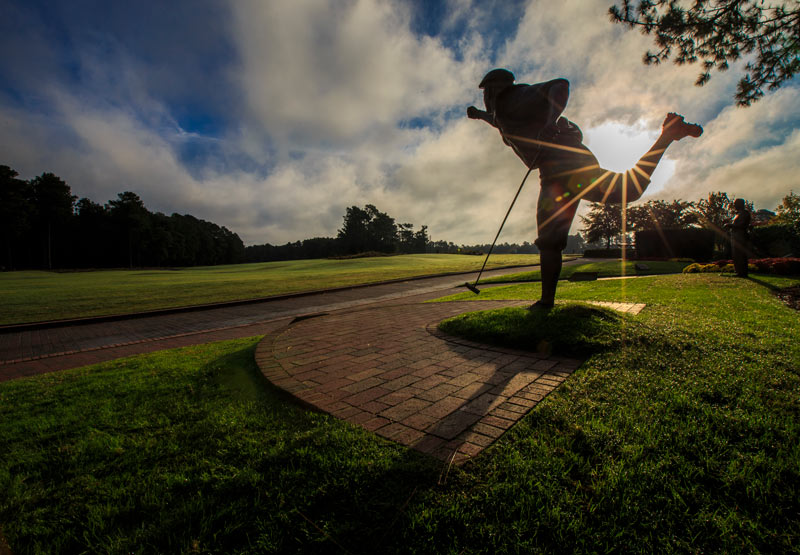
The bronze Payne Stewart statue on Pinehurst No. 2, memorializing the golfer’s celebration after making a 15-foot putt on the course’s 18th hole to win the 1999 U.S. Open. Photo courtesy of the USGA
Farren has been involved in 14 USGA championships, including three U.S. Opens, and was crucial in the unprecedented double of 2014, when No. 2 hosted the U.S. Open and the U.S. Women’s Open in consecutive weeks.
And there are more to come: The USGA last year announced Pinehurst would serve as an “anchor site” for the U.S. Open, to be played on No. 2 in 2024, 2029, 2035, 2041 and 2047.
“I’m fortunate that I’ve been able to do things many people have to change jobs every three or four years to get the opportunity to do,” Farren says. “In our profession, you might migrate to a course that holds regular Tour championships. Some like to be grow-in superintendents. Some like to do renovations. They relocate often. I’ve been able to do all that and not have to change my ZIP code.
“Honestly, I’ve never really had any inclination to leave. I’ve had conversations and offers, but I never really entertained the idea of leaving.”
An industry luminary

Of course, the measure of the man is more than the list of championships hosted or the number of greens regrassed, though, in Farren’s case, both of those are quite impressive. During festivities surrounding Farren’s induction into the Carolinas Golf Hall of Fame in 2018 — he was the 80th member, but only the third superintendent, prompting him at the time to lobby politely for the induction of more — Don Padgett, retired Pinehurst president and chief operating officer, took a turn at the podium and lauded Farren. Padgett estimated that, through acquisition or renovation during Farren’s tenure, Pinehurst had created 87 new golf holes, not including the rework of No. 2.
“Not even Donald Ross touched that many holes,” Padgett said. “Bob’s played an integral part in what Pinehurst has been and what it is now.”
But his highest praise of Farren had nothing to do with any of those holes.
“The quality of the man is incredible,” Padgett said. “I’ve never met anybody that I respect more, admire more, or of greater integrity.”
Among Farren’s myriad industry awards: GCSAA’s President’s Award for Environmental Stewardship in 2007; Golf Digest’s Green Star Award for outstanding environmental practices in 2014; and Anuvia’s Legends Award in 2018.
In addition to having been involved with the GCSAA Foundation for years and serving on various GCSAA committees, Farren is or has been a USGA Green Section committee member, on the Green Start Academy advisory board, a member of the Musser International Turfgrass Foundation board of directors, a board member of the First Tee of the Sandhills, and chair of the Village of Pinehurst Historic Preservation Commission.
“I hope I’ve been a positive mentor to people,” he says. “I’ve found that you intentionally pay it back, that it’s second nature to you, only if you truly enjoy what you’re doing. I feel strongly about that, regardless of your profession. I always try to make the point with my assistants in particular, that it’s important to be part of the community. When you’re part of the community, people look at you in a different light. You’re part of the community, not just the guy who takes care of the golf course.”
Kevin Robinson, CGCS, Pinehurst’s golf course maintenance manager and a 24-year association member, first met Farren three decades ago. He had an internship at Pinehurst, then returned as a spray tech on No. 2 when Farren was in the role Robinson now fills. Robinson has followed a career path similar to Farren’s, including a term as superintendent on No. 2.
Asked the first thing that comes to mind when considering his boss, Robinson didn’t mention the back-to-back U.S. Opens or the renovation to No. 2.
“He’s a family man,” Robinson says without hesitation. “He’s always supported us to attend our kids’ sporting events, for example. He always said there are people here to cover your work, but to make sure you take care of family first.”
Farren’s management style, Robinson says, is similarly nurturing.
“He’s a great delegator and a great coach. He’s not going to tell you how to do something, but he’ll provide you with the resources to get it done,” Robinson says. “For a long time, we used to have guys who were superintendents over multiple courses, but over the years, the demand for detail is just so much greater. It’s so hard to try to take care of multiple courses. Bob saw the benefit in making a guy superintendent over an individual course, to make it a little better for the golf course and the individual.
“And he’s a man of great vision. He knows how to help get us ready for what lies ahead in the future. We’ve seen two economic downturns, in 2008 and what we just went through with COVID, and we survived both. It’s crazy.”
Robinson’s favorite Farren tale has nothing to do with golf. Back in 1992, Robinson’s alma mater, North Carolina State (a school of which, despite his Marshall degree, Farren is particularly fond), was playing Iowa in the football Kickoff Classic at the Meadowlands in East Rutherford, N.J.
“I’ll never forget it. I was a spray tech, and Bob took me and several others, a mixture of superintendents and assistants,” Robinson recalls. “We drove all the way there, watched the game, and drove back. That was a long trip. For him being in the position he was in, to reach out to me as a spray tech ... I thought he could easily not know who I was. But to reach out and take me and give me that experience, it was incredible.”
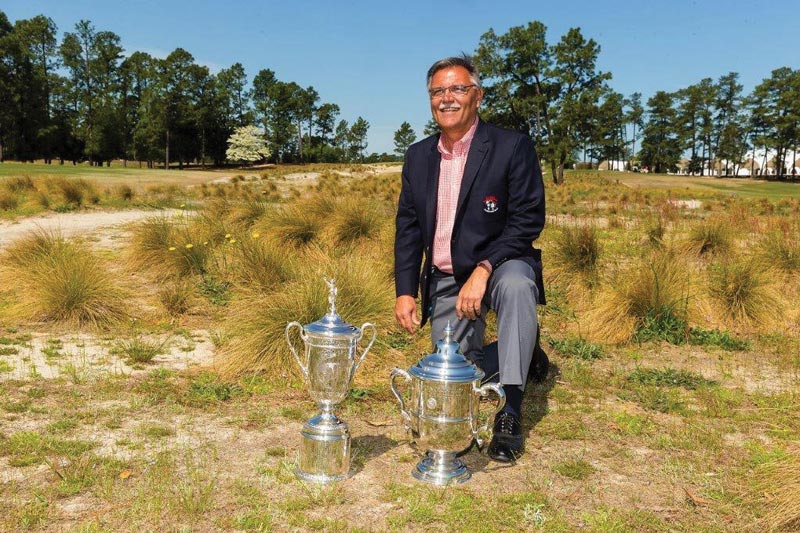
On the double: Farren with the U.S. Open trophies when Pinehurst No. 2 hosted the men’s and women’s Opens in consecutive weeks in 2014. Photo courtesy of Pinehurst Resort
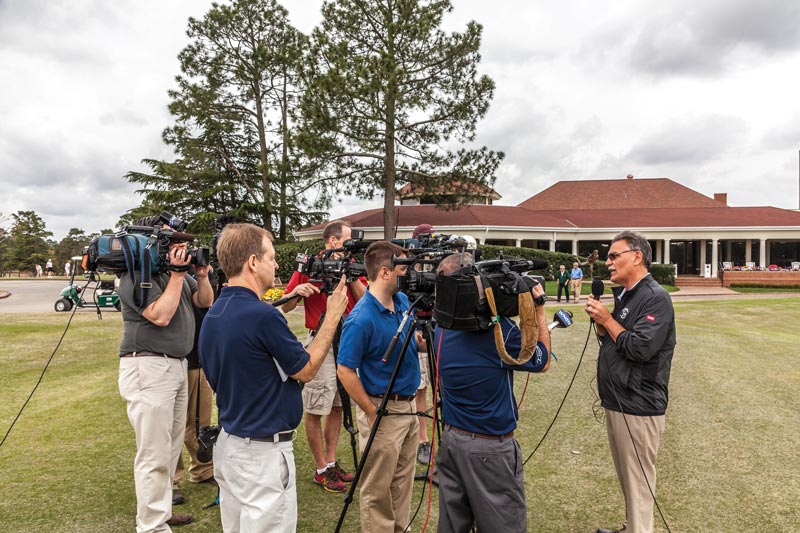
Farren holds court with assembled media prior to the 2014 U.S. Opens at Pinehurst No. 2. Photo by Scott Hollister
Logan Murphy, a GCSAA Class A superintendent who recently moved from superintendent on No. 8 to the same position on the higher-profile No. 4, may not have gotten the college football experience, but he still feels the personal touch, especially now that his office is just down the hall from Farren’s, to whom he occasionally refers as “the man, the myth, the legend.”
“He genuinely cares about people,” says Murphy, an 11-year association member. “He always asks, ‘How is the family? How are you doing?’ It’s not about the job. Yes, he cares about the job, but he’s concerned about people first.
“Anytime you have a question, he’s there to answer and help in any way he can. Especially that I’m now on 4, it’s the same job, but a new course, a new group, new challenges. I’m trying to get my feet wet, and it’s nice being back here where Kevin and Bob were so successful. I appreciate that he’s so accessible, but he doesn’t hover. He’ll let you figure things out on your own and make mistakes, and that helps you learn and grow. He’s so approachable and such a gentleman. I’ve never heard him say anything bad about anybody, ever. Not once.”
‘I’m so humbled’
Now, on to the business of the Col. John Morley Award.
Previously known as the Col. John Morley Distinguished Service Award, the honor had been open to anyone in the golf industry who had shown distinguished lifetime achievement. Since it was first awarded in 1932 — to Morley, GCSAA’s founder — superintendents, as well as researchers and other notable industry contributors, had been honorees. There were multiple recipients in most years. This summer, though, the Morley Award was elevated to Pinnacle Award status, resting alongside GCSAA’s Old Tom Morris Award, which has been awarded only since 1983 and will now be limited to those outside of the GCSAA membership who have helped mold the welfare of the game.
Only GCSAA-member superintendents are eligible for the new Morley Award — specifically, “those who have made an outstanding contribution to the advancement of the golf course superintendent’s profession. The contribution must be significant in both substance and duration, and may be, or have been, regional in nature.”
The significance of being the first of the new Morley Award winners isn’t lost on Farren. “That puts a little extra weight to it, to be honest,” he says. “I’m so humbled, I can’t even begin to tell you how proud I am, so excited to be a part of it.”
Now 64, Farren hasn’t seriously considered retirement, but there is a hard stop.
“We’ve been named an anchor site for the U.S. Open through 2047. I have no ambition to be here then,” Farren says with a laugh. “I told my wife, if something comes up that we’d love to do, we could talk retirement. But my son and his wife live an hour one way; my daughter is three hours away in the other direction. We get to spend a lot of family time together. It’s a great community. Really and truly, I don’t know what I’d rather do than come to work every day.”
Andrew Hartsock is GCM’s managing editor.